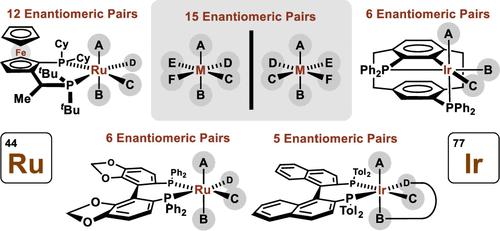当前位置:
X-MOL 学术
›
J. Am. Chem. Soc.
›
论文详情
Our official English website, www.x-mol.net, welcomes your
feedback! (Note: you will need to create a separate account there.)
Leveraging the Stereochemical Complexity of Octahedral Diastereomeric-at-Metal Catalysts to Unlock Regio-, Diastereo-, and Enantioselectivity in Alcohol-Mediated C–C Couplings via Hydrogen Transfer
Journal of the American Chemical Society ( IF 14.4 ) Pub Date : 2024-03-13 , DOI: 10.1021/jacs.4c01857
Jonathan Z Shezaf 1 , Catherine G Santana 1 , Eliezer Ortiz 1 , Cole C Meyer 1 , Peng Liu 2 , Ken Sakata 3 , Kuo-Wei Huang 4 , Michael J Krische 1
Journal of the American Chemical Society ( IF 14.4 ) Pub Date : 2024-03-13 , DOI: 10.1021/jacs.4c01857
Jonathan Z Shezaf 1 , Catherine G Santana 1 , Eliezer Ortiz 1 , Cole C Meyer 1 , Peng Liu 2 , Ken Sakata 3 , Kuo-Wei Huang 4 , Michael J Krische 1
Affiliation

|
Experimental and computational studies illuminating the factors that guide metal-centered stereogenicity and, therefrom, selectivity in transfer hydrogenative carbonyl additions of alcohol proelectrophiles catalyzed by chiral-at-metal-and-ligand octahedral d6 metal ions, iridium(III) and ruthenium(II), are described. To augment or invert regio-, diastereo-, and enantioselectivity, predominantly one from among as many as 15 diastereomeric-at-metal complexes is required. For iridium(III) catalysts, cyclometalation assists in defining the metal stereocenter, and for ruthenium(II) catalysts, iodide counterions play a key role. Whereas classical strategies to promote selectivity in metal catalysis aim for high-symmetry transition states, well-defined low-symmetry transition states can unlock selectivities that are otherwise difficult to achieve or inaccessible.
中文翻译:

利用八面体非对映异构体金属催化剂的立体化学复杂性,通过氢转移释放醇介导的 C-C 偶联的区域、非对映和对映选择性
描述了实验和计算研究,阐明了指导金属中心立体性的因素,以及由此产生的由手性在金属和配体八面体 d6 金属离子铱 (III) 和钌 (II) 催化的醇亲电试剂转移氢化羰基加成反应中的选择性。为了增强或反转区域、非对映和对映选择性,主要需要从多达 15 个非对映异构体金属复合物中选择一个。对于铱 (III) 催化剂,环金属化有助于定义金属立体中心,而对于钌 (II) 催化剂,碘化物对离子起着关键作用。在金属催化中提高选择性的经典策略旨在实现高对称性过渡态,而明确定义的低对称性过渡态可以解锁原本难以实现或无法获得的选择性。
更新日期:2024-03-13
中文翻译:

利用八面体非对映异构体金属催化剂的立体化学复杂性,通过氢转移释放醇介导的 C-C 偶联的区域、非对映和对映选择性
描述了实验和计算研究,阐明了指导金属中心立体性的因素,以及由此产生的由手性在金属和配体八面体 d6 金属离子铱 (III) 和钌 (II) 催化的醇亲电试剂转移氢化羰基加成反应中的选择性。为了增强或反转区域、非对映和对映选择性,主要需要从多达 15 个非对映异构体金属复合物中选择一个。对于铱 (III) 催化剂,环金属化有助于定义金属立体中心,而对于钌 (II) 催化剂,碘化物对离子起着关键作用。在金属催化中提高选择性的经典策略旨在实现高对称性过渡态,而明确定义的低对称性过渡态可以解锁原本难以实现或无法获得的选择性。































 京公网安备 11010802027423号
京公网安备 11010802027423号